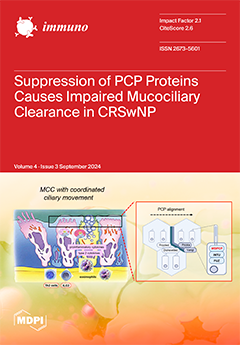Open AccessArticle
Impaired Coordination of the Ciliary Movement in Patients with Chronic Rhinosinusitis with Nasal Polyps: The Role of Decreased Planar Cell Polarity Protein Expression
by
Sakura Hirokane, Tomohiro Kawasumi, Sachio Takeno, Yukako Okamoto, Seita Miyamoto, Rikuto Fujita, Chie Ishikawa, Takashi Oda, Yuichiro Horibe, Takashi Ishino, Takao Hamamoto, Tsutomu Ueda and Koji Ikegami
Viewed by 708
Abstract
The planar cell polarity (PCP) of epithelial ciliated cells is essential for effective mucociliary clearance (MCC) in the sinonasal mucosa. We hypothesize that MCC coordination is impaired in nasal polyp (NP) mucosae due to the suppressed expression of a series of CPLANE (ciliogenesis
[...] Read more.
The planar cell polarity (PCP) of epithelial ciliated cells is essential for effective mucociliary clearance (MCC) in the sinonasal mucosa. We hypothesize that MCC coordination is impaired in nasal polyp (NP) mucosae due to the suppressed expression of a series of CPLANE (ciliogenesis and planar cell polarity effector) complex proteins in chronic rhinosinusitis (CRS) patients. To investigate this hypothesis, we subjected sinonasal mucosal samples to live video recording to measure mucociliary transport velocity (MCTV) and scanning electron microscopy to evaluate surface morphology. The expression and distribution of a panel of PCP proteins, e.g., WDPCP and FUZ, were investigated in relation to inflammatory cytokine levels and clinical features. The mean MCTV of NP mucosae was significantly lower than that of the inferior turbinate mucosae. The CRS group with NPs (CRSwNP group) (n = 28) showed increased expression of IL-13 and CCL26 mRNA compared to CRS patients without NPs (n = 25) and controls (n = 30). WDPCP and FUZ mRNA levels were significantly decreased in NP mucosae compared to ethmoid sinus mucosae in CRSwNP patients. WDPCP protein distribution was reduced in the cytoplasmic region of ciliated cells in CRSwNP patients. We conclude that suppression of WDPCP in ciliated cells is responsible for the impaired MCC of nasal polyps with type-2 inflammation. This mechanism might explain the decreased clearance and the potential for worsening symptoms of CRSwNP.
Full article
►▼
Show Figures





